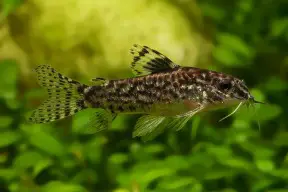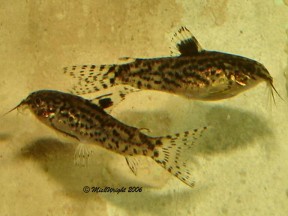Aspidoras pauciradiatus
SynonymsTop ↑
Corydoras pauciradiatus Weitzman & Nijssen, 1970
Etymology
Aspidoras: from the Ancient Greek ἀσπίς (aspis), meaning ‘shield’, and δορά (dora), meaning ‘skin, hide of an animal’, in allusion to the rows of bony plates on the flanks of genus members.
pauciradiatus: from the Latin paucus, meaning ‘few, little’, and radiatus, meaning ‘rayed’.
Classification
Order: Siluriformes Family: Callichthyidae
Distribution
Type locality is ‘Rio Araquaia near Aruana, 14°58’S, 51°04’W, Goias State, Brazil’, and this species appears restricted to the upper Araguaia basin.
Maximum Standard Length
30 – 35 mm.
Aquarium SizeTop ↑
An aquarium with minimum base dimensions of 60 ∗ 30 cm or more is recommended.
Maintenance
Ideally use a substrate of fine sand, although rounded gravel is an acceptable alternative provided it’s kept scrupulously clean.
Other décor is largely down to personal choice, but some cover should be provided to give the fish security.
This species requires stable, clean water conditions and should never be added to a biologically immature set-up.
Water Conditions
Temperature: 20 – 27 °C
pH: 6.0 – 7.0
Hardness: 36 – 215 ppm
Diet
Aspidoras spp. are foraging omnivores and will accept most sinking dried foods, as well as small live and frozen varieties such as chironomid larvae (bloodworm), Tubifex, etc.
Feeding a varied diet will ensure the fish are in optimum condition.
Under no circumstances should they be expected to survive on ‘left-overs’ from other inhabitants of the aquarium or relied on to ‘clean’ the aquarium.
Behaviour and CompatibilityTop ↑
Peaceful and gregarious. Should be maintained in a group of at least 4-6 individuals.
Sexual Dimorphism
Females tend to grow larger, and sexually mature individuals are noticeably rounder and broader-bodied than males, especially when gravid.
Reproduction
Spawning occurs in a similar fashion to Corydoras, and can often be initiated by undertaking a large water change with much cooler water, especially during a drop in barometric pressure.
NotesTop ↑
This species is sometimes referred to as ‘false corydoras’ or ‘sixray corydoras’.
A. pauciradiatus can be distinguished from congeners by possession of 6 soft dorsal-fin rays, as opposed to 7 in other Aspidoras species, plus its distinctive colour pattern.
Aspidoras species are distinguished from the very similar Corydoras spp. mainly by possession of two cranial fontanels, versus a single fontanel in Corydoras.
References
- Weitzman, S. H. and H. Nijssen, 1970 - Beaufortia 18(233): 119-132
Four new species and one new subspecies of the catfish genus Corydoras from Ecuador, Colombia and Brazil (Pisces, Siluriformes, Callichthyidae). - Britto, M. R., F. C. T. Lima, and C. R. Moreira, 2002 - Proceedings of the Biological Society of Washington 115(4): 727-736
Aspidoras velites, a new catfish from the upper rio Araguaia basin, Brazil (Teleostei: Siluriformes: Callichthyidae). - Ferraris, C. J., Jr., 2007 - Zootaxa 1418: 1-628
Checklist of catfishes, recent and fossil (Osteichthyes: Siluriformes), and catalogue of siluriform primary types. - Reis, R. E. , S. O. Kullander and C. J. Ferraris, Jr. (eds), 2003 - EDIPUCRS, Porto Alegre: i-xi + 1-729
Check list of the freshwater fishes of South and Central America. CLOFFSCA. - Weitzman, S. H. and M. H. Balph, 1979 - Proceedings of the Biological Society of Washington 92: 10-22
Some phylogenetic implications of a discovery of Aspidoras pauciradiatus (Pisces: Siluriformes: Callichthyidae) from the rio Negro in Brazil.






June 15th, 2012 at 7:10 pm
Matt,
don’t hate me for this, but things like ***It also has a much more distinctive patterning than the others in the genus, most of which appear similar to each other.***
need to be expanded upon.
(The reason I’m here btw is to see if SF has a good key to the genus….I just received the fourth species 😀 … and facing the horrible danger of mixing the fry before long!)
June 18th, 2012 at 8:03 am
It will be a while before this is updated Mike – concentrating efforts elsewhere at the moment and only one pair of hands I’m afraid…